Assemble the Team, Facilitator Notes
CUSP Toolkit
Contents
- Slide 1. Cover Slide.
- Slide 2. Learning Objectives.
- Slide 3. The Unit-Based CUSP Team.
- Slide 4. CUSP Team Members.
- Slide 5. Unit Team Characteristics.
- Slide 6. Team Member Characteristics.
- Slide 7. Building Your CUSP Team.
- Slide 8. CUSP Teams’ Group Processes.
- Slide 9. Team Performance.
- Barriers to Team Performance1.
- Stages of Engagement.
- Engage Team Members Using the 4 E’s2.
- Using the 4 E’s.
- The CUSP Project Leader's Role.
- Engage Physicians on the CUSP Team .
- The Physician Champion's Role.
- Physician Engagement.
- Engage Other CUSP Team Members.
- The Senior Executive's Role.
- The Nurse Manager's Role.
- The Patient Safety Coordinator/ Patient Safety Officer’s Role.
- Psychological Safety3.
- Psychological Safety.
- Exercise.
- Assemble the Team: What the Team Needs To Do.
- Summary.
- TeamSTEPPS Tools1.
- CUSP Tools.
- References.
Slide 1. Apply CUSP

Say:
The "Assemble the Team" module of the Comprehensive Unit-based Safety Program (or CUSP) Toolkit addresses CUSP team composition for your quality improvement initiative. This module will help you understand five concepts: the importance of teamwork and team composition to the CUSP initiative, developing a strategy to build an effective CUSP team, defining the roles and responsibilities of team members, identifying the characteristics of successful teams, and identifying barriers to team performance using TeamSTEPPS® and CUSP tools.
[D] Select for Text Description.
Slide 2. Learning Objectives

Say:
In this module, we will:
- Address the importance of your CUSP team,
- Develop a strategy to build a successful CUSP team,
- Identify the characteristics of effective CUSP teams and barriers to their performance as identified in TeamSTEPPS, and
- Describe the roles and responsibilities of CUSP team members.
[D] Select for Text Description.
Slide 3. The Unit-Based CUSP Team

Say:
To ensure the CUSP initiative is successful, the team should be actively involved, willing to spread the intervention, and committed to sustaining the gains across the unit. Remember that achieving the goals of the intervention rests with the CUSP team.
To encourage efficient implementation of the initiative, all team members should understand and apply the following concepts:
- Culture is local.
- The team is composed of engaged frontline providers who take ownership of patient safety.
- The team includes members with different levels of experience.
- The team is tailored to include members based on the clinical intervention.
- The team meets regularly.
- The team has access to resources necessary for the intervention.
The success of the CUSP initiative will depend on the unit team. The individuals that comprise the unit team are responsible for starting and sustaining the initiative, so their engagement and belief in the project will greatly contribute to its positive results.
To embody the local culture of the unit, the CUSP team should also include frontline providers with varying backgrounds and clinical expertise. For example, when collaborating to solve medication dosage errors, members of the CUSP team may find it helpful to invite the hospital pharmacist to join their team. The members of the unit team will apply their wisdom and background to engage other team members, develop educational materials, and execute the project. The collaboration between numerous disciplines and experience levels will help staff successfully carry out the CUSP initiative on the unit.
[D] Select for Text Description.
Slide 4. CUSP Team Members

Say:
Key CUSP team members include:
- Nurses, including educators and managers;
- Physicians; and.
- Senior executives.
Additional members who would be helpful to involve in the initiative are:
- Infection preventionists,
- Medical directors,
- Pharmacists,
- Respiratory therapists,
- Patient safety officers,
- Chief quality officers, and
- Ancillary or support staff.
The key CUSP team members—nurses, physicians, and senior executives—will help ensure the initiative is used effectively. However, input from other unit or hospital specialists is needed to guarantee efficient use of the CUSP initiative at the unit level.
[D] Select for Text Description.
Slide 5. Unit Team Characteristics

Say:
CUSP and TeamSTEPPS present similar approaches to team assembly and composition.
CUSP stresses that unit teams should:
- Have diverse local "opinion leaders" and dissenters, and
- Be willing to help spread the initiative.
TeamSTEPPS emphasizes that unit teams should:
- Develop a strong sense of collaborative trust and confidence,
- Develop a strong sense of collective trust, team identity, and confidence.
- These qualities allow team members to:
- Manage conflict by effectively confronting disagreements.
- Have a clear concept of team orientation.
- Trust other team members’ intentions.
- Believe in the team’s collective ability to succeed.
- Have a high degree of psychological safety (the psychological security of unit team members when they interact within the group).
TeamSTEPPS emphasizes that unit teams should:
- Manage and optimize performance outcomes, which will require them to:
- Communicate often, and at the right time, to ensure fellow team members have the information they need for superior contributions,
- Use close-looped communication,
- Learn from each performance outcome, and
- Strive to learn more.
CUSP and TeamSTEPPS both state that unit teams should:
- Have strong team leadership,
- Have defined roles and responsibilities, and
- Maintain clear values and a shared vision.
- These qualities promote:
- A common purpose,
- An engaging purpose, and a
- Leader who promotes the vision with the appropriate level of detail.
- Unit teams should also contain mechanisms for collaboration and feedback, such as:
- Provide mutual feedback regularly as a team,
- Establish and revise team goals and plans,
- Differentiate between higher and lower priorities,
- Have mechanisms for anticipating and reviewing team members’ issues,
- Review team effectiveness periodically, including its outcomes, processes, and vitality,
- Identify teamwork and task requirements,
- Distribute and assign work thoughtfully, and
- Integrate new team members consciously.
Having a strong unit team in place will help your unit reduce clinical errors, improve patient outcomes, improve process outcomes, and improve patient and staff satisfaction.
[D] Select for Text Description.
Slide 6. Team Member Characteristics

Say:
CUSP stresses that unit team members:
- Have a positive outlook,
- Are dedicated to the team’s initiative,
- Have broad vision, and
- Are detail oriented.
TeamSTEPPS stresses that team members:
- Provide quality information and feedback,
- Manage conflict skillfully, and
- Perform well as a group to reduce stress among team members.
CUSP and TeamSTEPPS both emphasize that team members understand their roles and responsibilities.
CUSP and TeamSTEPPS rely on the interest and skills of team members, from project inception, through intervention, and into project sustainability.
[D] Select for Text Description.
Slide 7. Building Your CUSP Team

Do:
Play the video.
Say:
- What reasons does the nurse manager give the senior executive for having a physician champion?
- What hospital staff members will be recruited to the CUSP team?
- Why does the nurse manager want the responsibility for the work to remain at the unit level?
[D] Select for Text Description.
Slide 8. CUSP Teams’ Group Processes

Say:
The effective group processes of CUSP teams include:
- Role clarity.
- Effective team communication.
- Conflict resolution.
- Education and engagement.
- Senior leadership buy-in, and support.
- Norms.
Successful unit teams have reliable processes in place for team members to work and communicate efficiently. Effective group processes provide opportunities for unit teams to hone their skills in the areas of leadership, role clarity, and development of shared interests, as well as collaboration and feedback.
Effective group work requires that all members share responsibility for group decisions and group interaction while working together on the CUSP initiative.
[D] Select for Text Description.
Slide 9. Team Performance
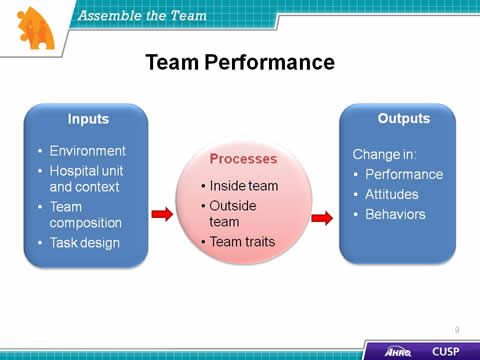
Say:
The unit team’s performance will determine the effectiveness of the CUSP initiative. Bearing this in mind, the inputs, processes, and outputs the unit team encounters are interconnected and influential in team development.
The unit team’s performance will be influenced by the:
- Environment.
- Hospital unit and context
- Team composition.
- Task design.
Environmental factors affect the implementation and sustainability of the initiative.
Depending on the unit type and staff composition, the engagement of unit team members may need to be adjusted to satisfy the context of the initiative. Applying a multidisciplinary approach when recruiting team members to the CUSP team will affect the quality of interventions the unit team carries out. Seeking team members from varying clinical backgrounds and with different levels and types of experience will help tailor the CUSP initiative to the needs of the unit. Devoting attention to task design will contribute to the success of the initiative.
As well as the inputs, processes alter the outcome of any initiative. These processes may require interactions that take place inside the team (internal) or outside the team (external) or involve team traits.
Internal CUSP team processes focus on the resources the team developed to organize and manage the workload at the CUSP level. External CUSP team processes involve the procedures the team carried out to put the initiative in action across the unit. The qualities of the unit team and leadership will determine the results of the intervention within the unit, whether the intervention is successful or must be delayed, and the general direction of the CUSP initiative. Depending on the inputs and processes of the CUSP team, the team’s outputs effect a change in staff performance, attitudes, and behaviors.
Bearing in mind that unit team inputs, processes, and outcomes are interconnected, teams will be able to modify their initiative to fit the needs of their unit. In doing so, they are ensuring the sustainability of the initiative and developing processes that will help support its goal.
[D] Select for Text Description.
Slide 10. Barriers to Team Performance1

Say:
Barriers to team performance include:
- Inconsistent team membership.
- Lack of time and information sharing.
- Hierarchy.
- Varying communication styles.
- Conflict.
- Lack of coordination and followup.
- Misinterpretation of cues.
- Lack of role clarity.
CUSP and TeamSTEPPS identify similar barriers to team performance. Inconsistency in team membership limits the strength and resiliency of the unit team. Teams that lack sufficient structure with a wide variety of input or that lack fully involved members will encounter difficulties with their performance. Teams that do not or are unable to devote the necessary time and energy to the initiative will also run into challenges with functionality. Time commitments should be shared equally among unit team members.
Hierarchy may impede unit team success by limiting opportunities for communication and interaction. If team members feel intimidated, the outcome of the initiative will be diminished.
Additional barriers to successful teamwork are conflict, lack of coordination, misinterpretation of cues, and lack of role clarity. While disputes are common when working in groups with diverse opinions, it is important to remember that conflict resolution and team interaction will help strengthen the initiative. Maintaining clear roles and task coordination will alleviate task or labor duplication, further promoting the success of the initiative.
[D] Select for Text Description.
Slide 11. Stages of Engagement

Say:
The CUSP Toolkit defines engagement as "to involve oneself or become occupied; to participate fully and deeply." Full engagement in the initiative will require unit teams to actively support the project and its goals.
As exemplified by the upward sweeping arrow, the stages of engagement while assembling a CUSP team may include feeling uninvolved, aversion, apathy, and fully engaged. When unit teams are fully engaged in the program, their performance improves, and the overall likelihood of the initiative’s success increases.
Ask:
How can you involve unit staff members in the initiative? How will you maintain their interest in and support of the project?
[D] Select for Text Description.
Slide 12. Engage Team Members Using the 4 E’s2

Say:
The 4 E’s engagement model will assist in identifying and recruiting team members. Created by the Johns Hopkins University’s Quality and Safety Research Group, the 4 E’s help teams implement patient safety interventions by focusing change efforts around technical and adaptive work. The model features four elements for starting and sustaining initiatives: engage, educate, execute, and evaluate. These four elements depict the primary means for engaging unit team members to ensure patient safety initiatives are carried out in a way that encourages sustainability.
Engage
Engagement primarily embodies adaptive work, in which unit teams help staff understand the results of preventable harm caused by a clinical problem. This is done by sharing stories about patients affected by a problem and estimating the number of patients who are harmed. Emphasizing unit team members’ involvement in improving the unit lends not only to the success of the initiative but also to the sustainability of the effort.
Educate
Education uses predominantly technical work and requires unit teams to guarantee that staff and senior leaders understand what is necessary to prevent a given clinical problem.
Execute
Execution of a sustainable intervention requires adaptive work. Unit team members will apply a plan of action based on the unit’s resources and culture and analyze their roles within the plan.
Evaluate
Evaluation is technical work and requires that the unit team collect and submit data to analyze the success of an initiative. In addition to data submission, this work requires unit team members to ask themselves, "How do we know we improved safety?"
Ask:
Think of a time when you needed to share an idea with a colleague. Re-create the encounter but use the 4 E’s to convince him or her of the value of your idea and answer these questions:
- How does this make the unit a better place?
- What do we need to know?
- What do we need to do?
[D] Select for Text Description.
Slide 13. Using the 4 E’s

Do:
Play the video.
Ask:
- What guidelines does the nurse manager provide to the CUSP team members to educate them about the avoidance of catheter-associated urinary tract infections?
- How does the Indwelling Urinary Catheter Daily Necessity Checklist contribute to the project?
[D] Select for Text Description.
Slide 14. The CUSP Project Leader's Role

Say:
Now we will explore each CUSP team members’ role. We will start with the CUSP project leader. This individual will:
- Be a frontline provider—a staff nurse, nurse manager, nurse educator, or physician;
- Encourage unit staff involvement in the initiative;
- Obtain staff feedback;
- Manage documentation of CUSP activities; and
- Educate staff about CUSP.
The project team leader serves as the unit’s primary contact within the CUSP team. This individual will organize and lead the CUSP team, articulate clear goals, make decisions using the collective input of CUSP team members, and promote and facilitate good teamwork and promptly disseminate information to the CUSP team members.
As a frontline provider, the project leader should be familiar with the hospital staff’s interests and needs. The project leader’s perspective on the initiative and its outcomes will endorse the sustainability of the project and provide other CUSP team members such as senior executives or pharmacists with the opinions and needs of frontline providers. The project leader is responsible not only for recruiting unit staff to participate in the initiative but also for maintaining unit staff interest and involvement after the initial excitement about the initiative has faded. The project leader will need to be aware of and attuned to the unit staff’s interests and needs. The project leader will also be accountable for obtaining and analyzing unit staff feedback related to the program. Essentially, the project leader will be the public face of the CUSP initiative and will serve as another point of contact between the unit staff and the team.
Ask:
Can you identify a potential project leader at your hospital who fits these characteristics?
[D] Select for Text Description.
Slide 15. Engage Physicians on the CUSP Team

Say:
When developing a CUSP team, it is crucial to engage physicians to work closely with members of the unit team. The physician champion who is recruited for the CUSP initiative must be capable of communicating and collaborating effectively with nurses, senior executives, and other team members participating in the initiative.
When engaging physicians on a CUSP team, it is important to:
- Identify physician leaders.
- Create an understanding of this role.
- Listen to physician concerns.
- Develop plans to address concerns.
- Reward physician leaders.
- Create a vehicle for communication.
- Develop a plan for communication.
Recruiting physicians to join the initiative will depend on the CUSP team leader’s ability to tailor the program to match the physician leaders’ interests and experience.
Ask:
How will you engage physicians to participate in the CUSP team?
[D] Select for Text Description.
Slide 16. The Physician Champion's Role
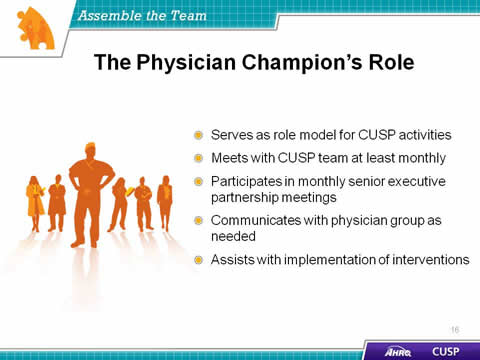
Say:
The physician champion is charged with advancing the initiative, bridging any communication gaps, and securing the buy-in of other physicians to participate in the CUSP initiative. Physician champions:
- Serve as role models for CUSP activities.
- Meet with the CUSP team at least monthly.
- Participate in monthly senior executive partnership meetings.
- Communicate with physician groups as needed.
- Help carry out initiatives.
The physician champion typically advocates and supports the initiative, providing the perspective of unit physicians. They assist the CUSP team by educating and communicating with their physician peers to further the aims of the initiative and ensure the unit physicians are involved with the program.
The physician champion is the physician equivalent of the nurse opinion leader or nurse manager on the CUSP team. We will discuss those roles in a few moments.
The physician champion also serves as the communication link between unit physicians and the team. Physicians on the unit have access to the physician champion to voice their concerns and needs. The physician champion attends meetings with the CUSP team at least monthly to help advance the initiative and take an active role in the unit team’s efforts. In addition to these meetings, the physician champion also joins monthly senior executive partnership meetings.
The physician champion plays a critical role in ensuring the hospital physicians are on the same page as the project lead. The physician champion functions as the leader for unit and hospital physicians while contributing to the initiative. Physicians not serving on the CUSP team can look to the physician champion for guidance and support when implementing the intervention.
Ask:
Can you identify a potential physician champion at your hospital who fits these characteristics and would be a good candidate to participate in a CUSP team?
[D] Select for Text Description.
Slide 17. Physician Engagement
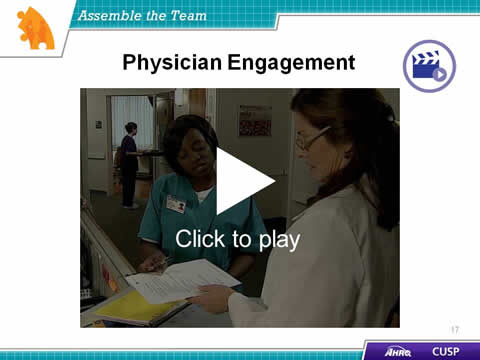
Do:
Play the video.
Ask:
What does the nurse manager suggest the physician champion do to engage other physicians on the unit?
[D] Select for Text Description.
Slide 18. Engage Other CUSP Team Members
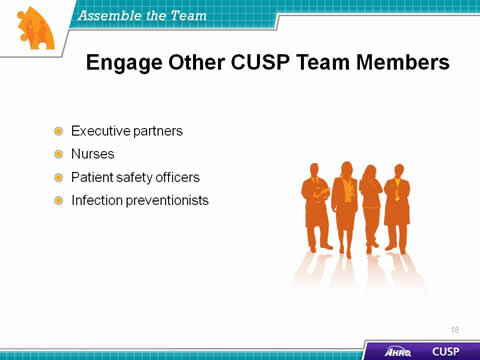
Say:
Engaging team members and other frontline providers will help sustain the effects and success of the CUSP initiative. As mentioned earlier, other CUSP team members may include, but are not limited to:
- Executive partners.
- Nurses.
- Patient safety officers.
- Infection preventionists.
When enlisting additional CUSP team members, identify the local opinion leaders within these unit roles. The opinion leaders are usually the go-to people for others in the hospital unit. They do not judge or belittle peers’ concerns and are willing to collaborate with peers to get answers to questions or address concerns. These individuals are excellent additions to the CUSP team because they will serve as the unit-wide representative for their practice area on the CUSP team.
For example, the nurse opinion leader can serve as the representative for all unit nurses on the CUSP team. This individual will deliver the concerns and needs of unit nurses to the CUSP team, disseminate the action plan, help unit nurses understand their role within the initiative, and address the interests of the unit nurses at CUSP team meetings.
[D] Select for Text Description.
Slide 19. The Senior Executive's Role
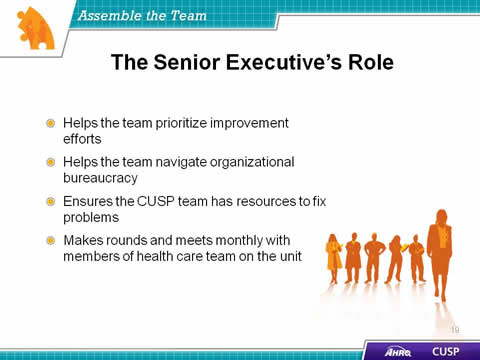
Say:
The senior executive:
- Helps the CUSP team prioritize improvement efforts.
- Helps the team navigate organizational bureaucracy.
- Ensures the CUSP team has resources to fix problems.
- Makes rounds and meets monthly with members of the health care team on the unit.
The senior executive is the executive leader who partners with the CUSP team and takes an active role in the CUSP initiative. The senior executive’s direct link with other hospital executives helps guarantee the initiative is taken seriously hospital wide and the project remains an organizational priority.
The senior executive helps the CUSP team navigate the organizational bureaucracy that may exist within the hospital. Using organizational ties and influence, the senior executive is able to secure attention from other hospital executives, outside agencies, and even local and State government leaders to enable the success of the initiative. Senior executives can also help secure supplies, funds, and staff resources. To fully understand the needs of the CUSP team, senior executives need to meet regularly with the CUSP team members and complete rounds with the unit team.
Senior executive team members should possess the authority to mobilize the resources needed to help the team resolve its patient safety issues. Senior executives should not be assigned to a specific unit, and their involvement within the CUSP initiative should not be based primarily on their availability to participate in meetings. The senior executive within the CUSP team should have a genuine interest in the initiative and be actively engaged in the team’s efforts.
For additional information on the role of the senior executive, see the "Engage the Senior Executive" module.
Ask:
Can you identify a senior executive at your hospital who fits these characteristics and would be a good candidate to participate in a CUSP team?
[D] Select for Text Description.
Slide 20. The Nurse Manager's Role
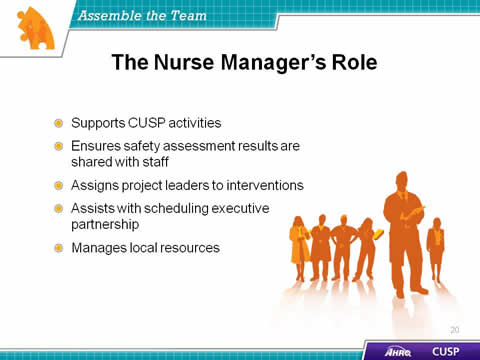
Say:
The nurse manager partners with the unit team and takes an active role in the CUSP initiative. The nurse manager on the CUSP team:
- Supports CUSP activities.
- Ensures staff safety assessment results are shared with staff.
- Assigns project leaders to interventions.
- Assists with scheduling executive partnership.
- Manages local resources.
The nurse manager supports CUSP activities by communicating the CUSP team’s needs to the unit nurses. The nurse manager is likely the nurse opinion leader; accordingly, he or she already serves as the key contact for the unit nurses and helps empower the unit nurses throughout the initiative. The nurse manager makes sure the staff safety assessment results are shared with hospital staff and the unit nurses’ findings are shared with the CUSP team at meetings.
Nurse managers also oversee the distribution and maintenance of local resources. These resources may include staff time, supplies, or education and training, all of which greatly influence the outcome of the initiative.
Ask:
Can you identify a nurse manager at your hospital who fits these characteristics and would be a good candidate to participate in a CUSP team?
[D] Select for Text Description.
Slide 21. The Patient Safety Coordinator/ Patient Safety Officer’s Role
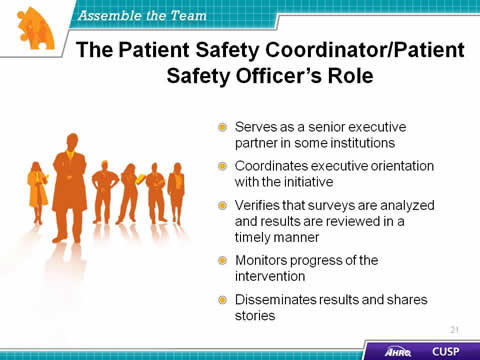
Say:
The patient safety coordinator or patient safety officer supports the goals of the CUSP initiative to guarantee that it is patient centered.
The patient safety coordinator helps develop and sustain the initiative by coordinating executive orientation. Because these staff members are executives in some institutions, their ties with the hospital’s executive branch may also advance the goals and needs of the initiative among hospital executives. These individuals are able to apply their clinical and executive statuses to bridge the gap between these fields within the hospital, increasing communication and opportunities for cross-training between the fields.
The patient safety coordinator also assists the CUSP team by ensuring the timely analysis and sharing of survey results with the team, staff members, and senior executives hospital wide. In serving as another link between the clinical and executive branches of the hospital, the patient safety coordinator monitors the intervention’s progress and presents the unit teams and executive team with a nonbiased assessment of the project. The patient safety coordinator also disseminates results and shares stories.
Ask:
Can you identify a potential patient safety coordinator or officer at your hospital who fits these characteristics and would be a good candidate to participate in a CUSP team?
[D] Select for Text Description.
Slide 22. Psychological Safety3
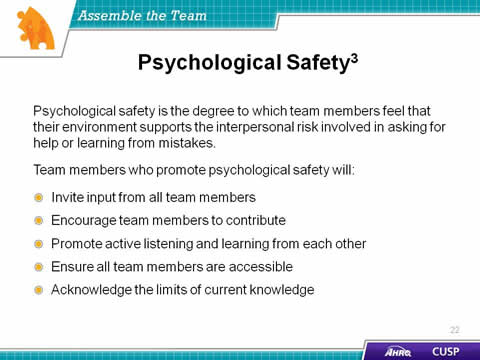
Say:
Once the CUSP team forms, team members must all feel supported in sharing ideas with team members. Psychological safety is a term that describes the psychological security of team members when they interact within the group.
Psychological safety involves all team members:
- Proactively inviting everyone’s input by giving permission and encouragement to speak up,
- Listening and learning from each other,
- Being accessible, and
- Acknowledging the limits of their current knowledge.
[D] Select for Text Description.
Slide 23. Psychological Safety
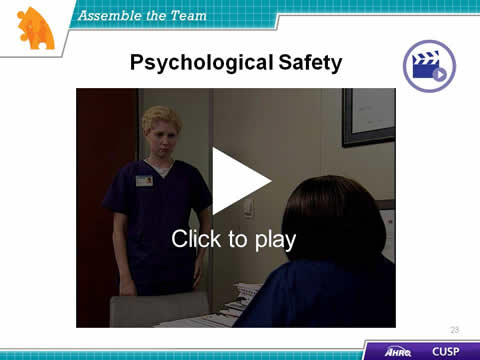
Do:
Play the video.
Ask:
- Why does the nurse manager meet with the nurse assistant?
- How does the nurse manager encourage the nurse assistant to speak up while participating on the project?
- Why is psychological safety important when working within a project team?
[D] Select for Text Description.
Slide 24. Exercise
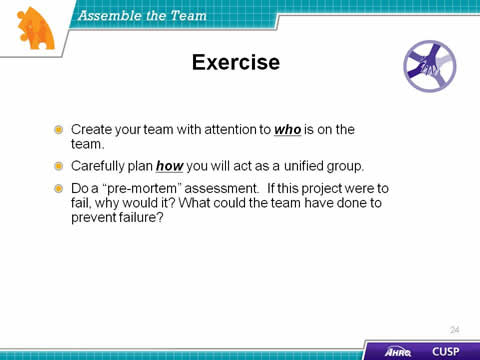
Say:
Prepare yourself to implement CUSP in your unit. Identify a quality improvement issue and begin to think about who should be on the team:
- What roles will need to be filled for the team to get the most out of this initiative?
- Who is best suited to perform those roles on this team?
- How will you engage and recruit these staff members?
Carefully plan how you will act as a unified group and then do a "pre-mortem" assessment.
- If this project were to fail, why would it?
- What could the team have done to prevent failure?
[D] Select for Text Description.
Slide 25. Assemble the Team: What the Team Needs To Do
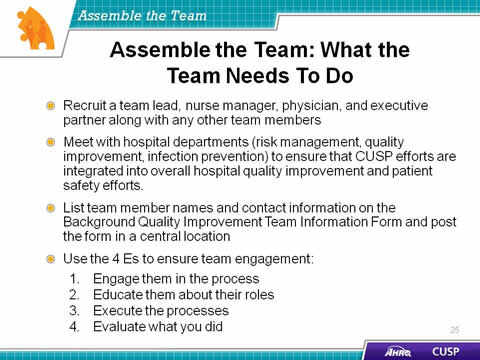
Say:
Several actions contribute to the CUSP team’s success. First, team leaders must get the right people to the table. Team leaders should recruit a nurse manager, a physician champion, and a senior executive. Health care providers from the unit who will be engaged should also be actively recruited.
Key hospital departments, such as risk management, quality improvement, and infection prevention, that may have an interest in the work of the CUSP team should be included to integrate CUSP efforts into overall hospital quality improvement and patient safety efforts.
Team members’ names and their contact information should be listed on the Background Quality Improvement Form, which should be posted in a central location.
Team leads should remember to use the 4 E’s when recruiting CUSP team members:
- Engage team members in the process.
- Educate them about their roles.
- Execute the processes.
- Evaluate what was accomplished.
[D] Select for Text Description.
Slide 26. Summary
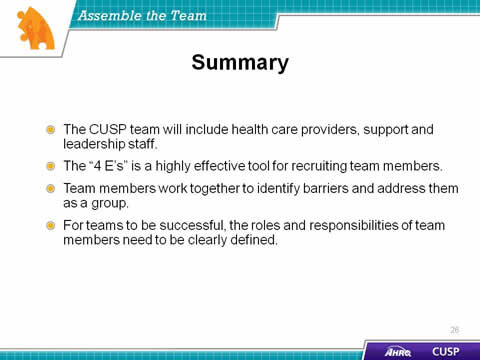
Say:
The CUSP team should have representatives from provider, support, and leadership staff.
Team leads should keep the 4 E’s in mind when recruiting team members: engage, educate, execute, and evaluate.
The CUSP team will work as a group to identify barriers and solutions.
Each team member’s role must be clearly defined.
[D] Select for Text Description.
Slide 27. TeamSTEPPS Tools1
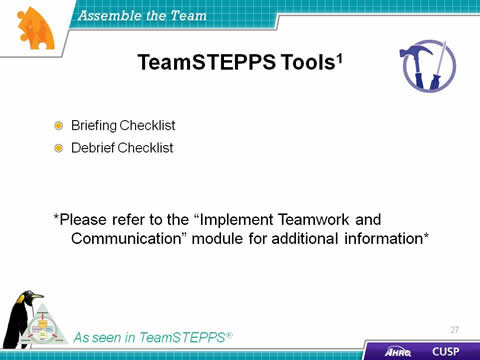
Say:
In addition to the information presented in this module, CUSP tools are available online at the AHRQ Web site: www.ahrq.gov/cusptoolkit. The tools will help clarify the roles and responsibilities of the team and assess unit team culture.
Background Quality Improvement Team Information Form
The Background Quality Improvement Team Information Form will help the unit team identify CUSP team members in their hospital unit. Team members completing this form are committing—in writing—to their role on the CUSP team. In addition to outlining assignments, the document contains staff contact information to encourage interaction among the CUSP team members and promote teamwork.
Culture Check-up Tool
The Culture Check-up Tool will help the unit team address problems identified in the unit patient safety culture assessment. This tool aids in the understanding of unit culture and will help the CUSP team carry out interventions to improve the local culture. With the tool, unit teams review the patient safety culture results to identify potential barriers and strengths team members can use as a basis for making culture and patient safety improvement decisions. Focusing the culture conversation on group-level data depersonalizes the discussion and fosters improvement in the context of the local realities of care delivery. The team can use the tool to target a goal for improvement shortly after the culture assessment and every 3 to 6 months, or as needed, to encourage culture conversations, evaluate cultural issues between survey administrations, and monitor the progress of culture change.
[D] Select for Text Description.
Slide 28. CUSP Tools
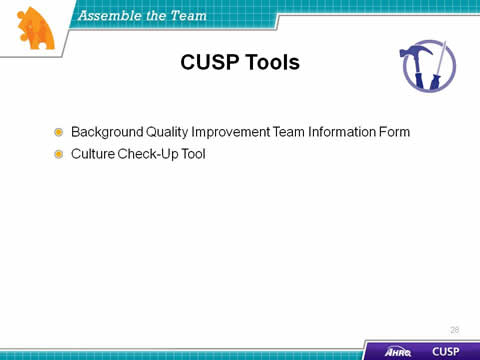
Say:
Two TeamSTEPPS tools can facilitate communication among CUSP team members and clarify their roles and responsibilities. These are the Brief and Debrief Checklists. These tools are reviewed in the "Implement Teamwork and Communication" module of the CUSP Toolkit.
*Please refer to the Implement Teamwork and Communication module for more information*
[D] Select for Text Description.
Slide 29. References
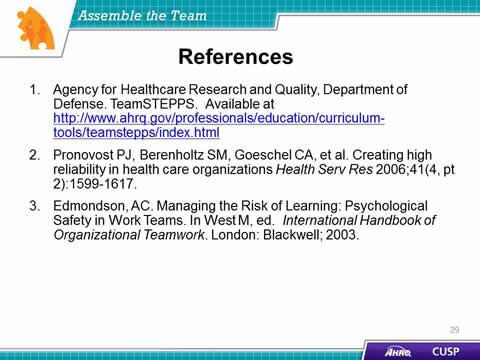
[D] Select for Text Description.



